How to succeed in push-ups, how to increase reps in push-ups, how to increase strength in push-ups.
If there is one exercise that is problematic for many, it is a pull-up done wide in front of a stationary bar. Questions regularly arise about how to progress, be it reps, strength (with ballast), or simply how to get ahead.
So, in this article we will see how to succeed in push-ups when we fail, a path that can be reached without interruption; how to increase reps when you can only do 3 reps, and how to increase strength when you are very strong.
We’ll start with the leader with the goal of doing wide chin-ups in front of a fixed barbell, a basic version for working out the spine, and a near-full back! (The use of the variant in supination or in a hard neutral grip does not allow, even in the process of advancement, to progress in this version in a wide grip in front).
1. Rows: Correct Technique
A wide pull-up in front of a fixed barbell is a technique. It’s not about wriggling all over the place, throwing your legs forward, or rolling on a frog.
Unfortunately, there will be no muscle progress when using one or both of these methods. The fact that the upper back is rounded and the ribcage retracted does not allow for good contraction of the spinal muscles and therefore V-shaped development at will.
Therefore, the correct way to pull up requires more strength, and they do it like this:
The ribcage should remain extended throughout the entire exercise, you should pull straight under the barbell as far as possible, and should not swing. To avoid wobbling, you must pull with your muscles, not impulsively while gaining.
As for the lift, for performance purposes we pass the chin over the bar. For bodybuilding purposes, however, partial amplitudes can be used to build muscle mass, but that is not the purpose of this article.
2. Pull-ups: what are pull-ups?
Rows, taken wide in front of a fixed bar, act mainly on the outer back and develop back width, the famous V:
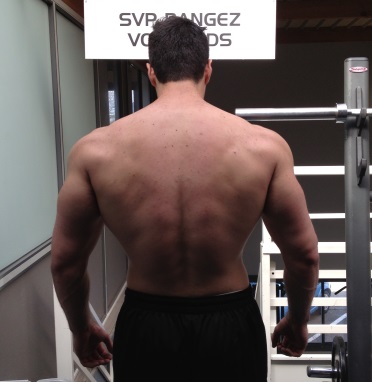
To work better with this outer part, you shouldn’t go too high (nose over the bar), without which you will have to tilt your chest back, and the exercise becomes a hybrid between pulling up and rowing.
Then it is possible by changing his grip and his lift to the pull-up to develop the back almost completely – except for the lumbar.
Thus, performing hard, neutral pull-ups by bringing the lower pectoral muscles to the bar theoretically develops the inner dorsal region, as well as the middle and lower trapezium.
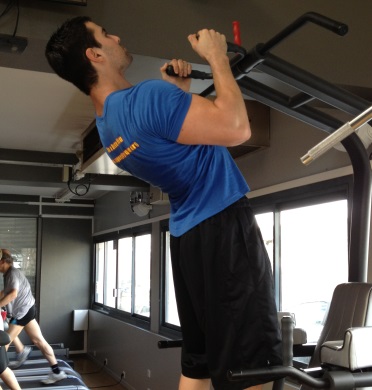
Between these two extremes, you can endlessly vary his grip and chest tilt to maximize back development.
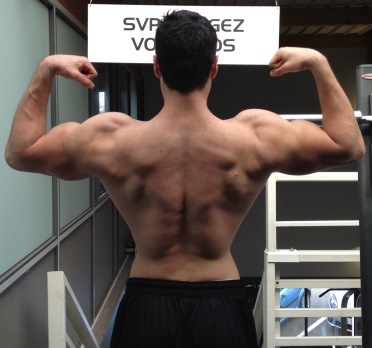
3. First case: I can’t stop
When you start resistance training, it’s very rare to do push-ups right away. Difficulty increases with weight, the heavier you are, the more difficult.
This is why we usually see wandering stables on a fixed panel.
There is no need to despair if you cannot get up, there are progress solutions that will surely allow you to start progressing with jerks made wide in front of a fixed rod.
There are two main solutions:
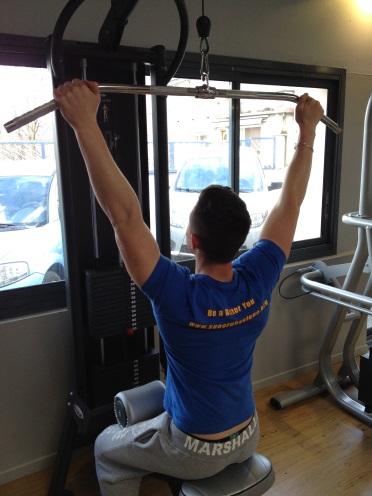
This is a simpler version in the sense that:
We are sitting, and there is no gain not to sway. This way, we can focus exclusively on the upper body technique, with the cage extended, while remaining straight.
You can choose your weight. Thus, you no longer need to lift weights, but weights that you can lift and progress gradually.
To be able to pull up in front of a fixed bar, you need to consistently increase your body weight using a high pulley.
More efficient for quick pull-ups is a casting machine, which is unfortunately not very common in movie theaters.

Unlike the pulley we are sitting on, we are in a position close to the one we find on the crossbar, although the movement is directed. There is a little cladding concept introduced right here to shoot straight.
We also have a feeling of tension in our body as we take off weight thanks to the counterweight. So over the course of weeks and months, we remove the counterweight to finally stop putting it on and go up in the bar.
There is a third solution, which we do not particularly like, is the use of an elastic band, which, although it makes it easier, changes the dynamics of movement.
4. Second case: I am doing 3 reps and would like to do more
When you only manage to complete a few reps, it is very difficult to progress because you do heavy sets on a different exercise and try to progress in each session.
In our article How many reps do you need to gain muscle mass? We explained that the shorter the series, the more difficult it is to move from session to session, because the percentage of progression to win was too high. This is why we recommend using mostly medium and long series.
We’re extrapolating here the fact that you don’t have machines, i.e. a pulley and a dump machine, in which case progressing on either of those two options will allow you to get more reps to easily progress into long runs on it.
This way you only have a fixed bar and want to win rehearsals. You are currently doing 3 with strict technique.
The best way to get ahead here is to go tonnage, that is, multiply the number of runs by doing multiple reps, each with a low cooldown. In this way, we avoid “burning”, emptying our strengths, and reducing more volume (series × reps) per session than if we were completely forced from the beginning, which would quickly give a “hanging technique” (I stay on the hook, unable to lift themselves).
Specifically, to convince you of the merits of our arguments, we will compare, supporting figures, two approaches:
I do 3 reps carefully on the first set, then 2 reps in a row, then I manage to do 3 or 4 sets of 1 repetition, which adds up to a total of 9 reps with luck.
I do at least 10 sets of 1 rep, which gives us a minimum of 10 reps, yet we were never fully able to apply this technique (it’s hard to stay strict on short sets, especially when completely) and “succeeded” (concept which I develop in my e-book: Rudy Coya – My Secrets to Building Muscle Mass – Volume 1).
We offer you an example of a cycle that allows you to double the number of reps in 8 weeks and therefore get 6 reps. The recovery time is 1’30 between each series.
| Monday | Thursday | |
|---|---|---|
| Week # 1 | 10 reps: 10 × 1 |
10 reps: 5 × 2 |
| Week # 2 | 12 reps: 2 × 2 8 × 1 |
12 reps: 6 × 2 |
| Week # 3 | 14 reps: 4 × 2 6 × 1 |
14 reps: 7 × 2 |
| Week # 4 | 16 reps: 6 × 2 4 × 1 |
16 reps: 8 × 2 |
| Week # 5 | 16 reps: 8 × 2 |
15 reps: 5 × 3 |
| Week 6 | 22 reps: 10 × 2 |
18 reps: 6 × 3 |
| Week 7 | 22 reps: 2 × 3 8 × 2 |
21 repetitions: 7 × 3 |
| Week 8 | 24 reps: 4 × 3 6 × 2 |
maximum number of repetitions! |
Then you can adapt our program to get a few more repetitions as soon as you get the idea
5. Case 3: I want to gain strength in chin-ups
In this third case, we proceed from the assumption that you are already doing fifteen reps and want to gain strength in order to reach, for example, the level of the SuperPhysics Club Legend, that is, 10 reps with 20 kg of ballast or just take more back!
The best way to increase strength in pull-ups is to train with ballast, that is, with extra weight that can be attached with a seat belt or that can be put on a backpack. We are not a fan of wedging weights between the legs, it can quickly degenerate (the weight slips) and your streak will screw up
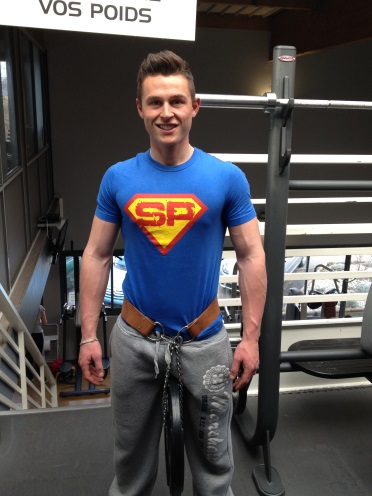
We are progressing in this way with a routine exercise that we would like to focus on, and therefore we can do weighted pull-ups twice a week to progress faster if your recovery allows you.
6. example of a typical push-up program
Now let’s look at a sample program for someone who wants to focus on push-ups in their training program, assuming you train 4 times a week indoors.
The number of repetitions, for example, is determined from our article. How many reps do you need to do to gain muscle mass? , We provide only examples in the program below.
The recovery time between exercises is chosen according to our article. How long should you rest between sets of exercises?
This is just an example of a program that adapts to you.
Wide front rods or options depending on your case.
High Row, Neutral Grip: 3 × 8-12.
One-Arm Row with Dumbbell: 3 × 8-12.
Partial Row: 3 × 8-10
Hammer Curl: 3 × 12-15
Reverse Pulley Curl: 3 × 12-15
Crunch on a high pulley: 3 × 15-20. Pool wrap suspended from a fixed rod: 3 × 15-20
Incline Bench Press: 3 × 8-12. Downward Bench Press: 3 × 8-12. Pulley spacing: 3 × 12-15
Neck lengthening: 3 × 12-15. Pneumatic press: 3 × 12-15. • Pulley rollback: 2 × 15–20.
Rods taken in front or width, depending on your case.
Rowing bar top: 3 × 8-12. Seated rowing on a low pulley with one hand: 3 × 12-15.
Height to the side of the pulley: 3 × 15-20
Bird with dumbbells: 3 × 15-20
Military bench press: 3 × 8-12
Crunch: 3 × 15-20
Pool Wrap: 3 × 15-20
Breaking Squat: 3 x 8-12
Incline Leg Press: 3 x 10-15
Seated Leg Curl: 3 × 10-15. 90 ° extension to the lumbar bench: 3 × 15–20.
Machine standing calves: 3 × 10-15
Output:
In this article, we’ve seen how to progress in push-ups, whether it’s to do it, progress in reps, or just gain strength.





